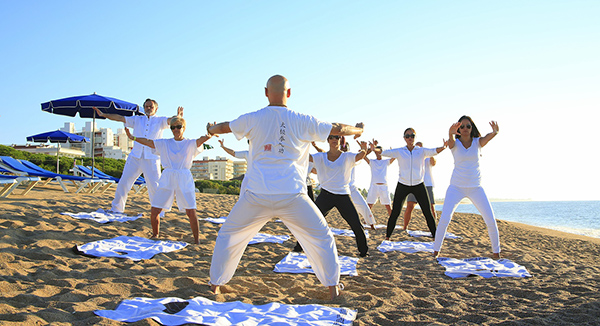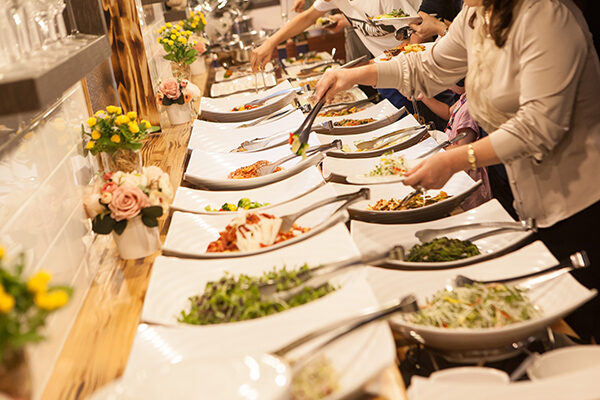
As qigong students and practitioners begin their qigong journey they quickly discover that there is vast diversity of qigong practice, so many different qigong exercises and sets, each with their own purposes and benefits. It is fascinating to try these different practices and experience the different effects and benefits that each of them have to offer, but with so many different practices to choose from, I am often asked: How do you select which ones to do each day?
We can think of doing qigong as being a bit like cooking. There are so many different dishes that we can learn to cook, and each has their own unique flavours and nutritional benefits. It is wonderful to have a variety of options so that we can cater to our own and other people’s specific nutritional needs, or even just what we feel like eating at different times, but this doesn’t mean that we need to be constantly changing what we eat.

Within the vast variety of different foods and dishes available to us, we can follow some simple principles to choose what we wish to eat and to establish healthy habits. The same is true of our qigong, and this article will explore some of those principles that you may keep in mind when choosing what to practice each day.
It is also likely that you will find that over the years you go through different phases within your qigong practice, and that your needs and focuses change, and therefore what you choose to include within your daily practice will also change. Just as you may develop some healthy eating habits, but your dietary needs change over time, and so you change and adapt your eating patterns to your developing needs. This article will also give consideration to these different phases within our qigong journey. Specifically, we will look at the phases of discovering, learning and deepening, maintaining, and therapeutic application.
Discovering Qigong Practices
This is an exciting phase of your qigong journey, and a place where everyone starts. When you first begin your qigong journey every practice is new to you. You may be exposed to just a few practices, or maybe out of curiosity you seek out and try many different practices during this stage. If you are happy with and perhaps intrigued by the first practices you encounter, then there is nothing wrong with proceeding directly to the next phase of learning them thoroughly and deepening your practice of them, but it is also quite healthy at this stage to look around and try a variety of different qigong practices. Trying several different qigong practices gives you the opportunity to discover some of the vast diversity of qigong practice that exists, to get a little bit of a feel for different practices, and to find practices that you find particularly enjoyable and beneficial to you. By exploring different practices you will put yourself in a better position to choose some suitable practices to focus on as you move to the next phase of your qigong journey.
Learning, and Deepening Your Qigong Practice
It is fun to discover and experience new things, but if all you ever do is try one qigong practice after another, you will only ever develop a superficial understanding of those practices, and of qigong as a whole. There are many aspects of qigong practice that are quite subtle, and to really experience a practice fully, and understand its nuances, we usually need to spend some time focusing in on that practice and doing it regularly. This allows us to notice details of the practice, to give our body time to gently change and adapt to the requirements of the practice, and to develop the necessary awareness and skill with our energy so that we can truly achieve the purposes of the practice.

Historically some qigong traditions have given guidelines of how long a given qigong practice should be practiced for in order to experience it fully and gain its benefits. One such guideline that you may have heard of is the “100 day gong” – spending a period of one hundred days doing the practice in question every day. There isn’t anything magical about the number 100, it is likely that you will achieve similar with 99 days, or 101 days of practice, but it does give a good idea of the sort of time that qigong practitioners across generations have found it takes to truly experience and understand a new practice. Once you have discovered a practice you enjoy and would like to understand properly, you will find it useful to practice it regularly for several months to deepen your experience of it and gain the skills that come from that particular practice.
Maintaining Your Qigong Practice
After you have dedicated some time to really experiencing and understanding a set of qigong practices, you may discover that there are other intriguing qigong practices that you want to learn. Each new practice you learn will give you new tools for working with your energy in specific ways to give specific benefits. They will also give you a broader perspective of qigong as a whole, and as your knowledge develops you may even find that they give you new insights into other practices that you have already worked with previously.
To learn new practices properly and really understand and experience them, you need to go through a process similar to the ones that you first learned, focusing on them and practicing them regularly for several months. Its at this stage that qigong students often start to wonder and ask questions about how they can maintain all the different qigong practices that they have learned, are learning, and perhaps wish to learn in the future. They have got used to practicing their qigong sets everyday as they learned and deepened their experience of them, but now that they are taking on new practices it starts to become impractical to continue to practice them all each day.

Fortunately, having learned a qigong practice well, most people find that it is a bit like riding a bike, you retain the skills and awareness quite well even if you don’t practice it so often. So at this stage of your qigong journey it is fine, and often even necessary to put aside practices that may have previously been part of your daily routine so that you can focus fully on the new ones you are learning. You don’t need to worry about forgetting those other practices though, if you have learned them well you will be able to pick them up again easily once you have gone through your process of learning and deepening your experience of some new practices.
Sometimes students are still reluctant to put aside practices that have become so familiar to them and that they have come to enjoy so much, but sometimes as a practical matter it is just something you need to do so that you have enough time and focus to dedicate to the new practices you are learning. Sometimes we need to let go of one thing, at least for a time, so that we can effectively take on something new. Another option for qigong students who really miss their previous practices even while focusing on learning new ones, is to set themselves a schedule of practicing their new practices most days, but periodically, maybe weekly or even monthly allowing themselves enough time that they can also practice some of their old favourites. We will look more at the dynamics of how and why you might do this in the section of this article on Structuring Your Qigong Practice.
Therapeutic Application of Qigong Practice
Another phase, or aspect of qigong practice that is very relevant to which practices you choose to do on a regular basis is the therapeutic application of qigong practice. You might have some specific issues with your body or your energy that you wish to address, and may have selected some qigong practices to help you with that, or perhaps you have had them prescribed for you by a skilled clinical qigong practitioner. This will clearly affect what you include in your regular qigong practice routine. There are different ways that qigong practices might be used therapeutically. Sometimes it may just be a matter of including one, or several qigong exercises alongside whatever other practices you might be doing – you can think of this a bit like taking some vitamin and mineral or herbal supplements or medications along with your regular meals. At other times it may require putting aside any other practices to just focus on the ones that your really need at that time – this would be more like going on a special diet to resolve your issue.

In addition to this, many qigong practices work with different aspects of our energy systems such as our organ meridians, dantien, extraordinary meridians, and energy fields, and the character of our energy such as the balance between yin and yang, and the harmony of the five elements. These practices are sometimes used for specific therapeutic effect, or more generally to bring health and balance to the energy systems. Even after having cleared and balanced our energy with our qigong practice, throughout our lives different influences from our environment, or stress, injury, or emotional trauma can throw these systems our of balance or cause them to become blocked. The practices can often serve both a diagnostic as well as a remedial purpose, as doing the practices will often make it evident where blockage or imbalance is occurring. So periodic practice of these types of qigong practice can also be considered another type of therapeutic application – an opportunity to evaluate the energy systems and reset and rebalance them where necessary through the practices.
So any illness, injury, or energy imbalance you may experience, or any regular maintenance you need to maintain the health of your energy systems will be another factor that influences what you choose to include in your regular qigong practice.
You Can Be In Several Phases At Once
As you continue along your qigong journey, you may find yourself repeatedly in each of these phases of your qigong practice, or perhaps several, or even all of the phases at once.
If you have gone deep into a set of qigong practices for a period of time, you may find yourself seeking some new inspiration or variety in your practice and so you return to the discovering qigong practices phase. Or, you may have a regular qigong practice that you are maintaining, while also learning something new, and of course issues that may benefit from the therapeutic application of qigong practice can occur at any time.
The Best Practice Is Often A Simple Practice
As you progress in your journey and acquire knowledge and experience of a wider and wider range of qigong practices, it can become harder to choose between them to decide what to practice at any given time. This is where cooking and our regular eating patterns serves as a useful analogy again.
Over your lifetime you may have learned to cook many different dishes, you may have even really spent some time refining and perfecting your ability to prepare some of them, but this doesn’t mean that you ever try to eat all of them at the same time. Much as you may really enjoy several of the dishes that you know how to prepare, you understand that each has a time and a place. You make choices between the vast array of possibilities, often according to what you need to be healthy, or sometimes based just on what you feel like eating at a particular time. Even though some of the dishes you know how to cook may be quite intricate and fancy, you will often find that what you eat on a regular basis is quite plain and simple, and you bring out the more involved recipes only from time to time, or on special occasions.

In a similar way, even as you accumulate more and more different qigong practices to choose from, often you will find that what is satisfying and most beneficial to you on a regular basis is quite simple. You are better off not trying to cram in too many different qigong practices into your regular routine, instead focusing on just a few that give you the benefits that you need at that time. In my experience, in many ways the more experienced you become as a qigong practitioner, the simpler your regular qigong practice will often become. Many days in my own practice I may focus on only a single movement or meditation, and it is deeply satisfying and beneficial. It’s a bit like having lots of different options of what to have for breakfast and choosing to just have some toast. Often keeping it simple will be the most satisfying and best for your overall wellbeing.
So How Do You Choose What To Practice Each Day?
With all of these principles in mind, we can consider how to choose what to practice each day. Factors that will influence this may include:
- How much time you have available for your practice. If you have only a few minutes available on a given day, you will of course need to narrow down your choices and focus on just one or a few qigong practices. You gain the most benefit from your qigong practice when you do not rush it. This does not mean that you need a long time to have an effective and beneficial practice, but rather that if you do not try to squeeze too much into your qigong practice sessions so that you can relax into your practice and truly experience each of them. Even a few minutes of practice can be deeply rewarding if we relax fully into it. Of course if you have the luxury of more time, you may be able to include several different qigong practices into each daily session in an unhurried way.
- If there are specific practices that you are working on learning and deepening, these of course will take a high priority within your regular practice. It often requires consistent dedication over a period of time to truly grasp the essence of a practice. So when taking on a new practice you may choose to focus solely on that for a period of time, or at least make that practice your top priority and then fit other practices into your routine only when you have available time and focus.
- If you have specific health or maintenance requirements within your practice then this will also be a big influence on what you choose to include each day. As mentioned previously, at times this could mean setting aside any other practices so that you can just focus on the ones that you have specific need for, or at other times it might mean just allowing a few minutes each day to include a specific exercise you need to work on for therapeutic benefit – which you can easily fit in alongside any other practices you might wish to do.
- Environmental influences such as the change of season or particular events around you might also influence your choice of practices. For example in winter you might choose to put more focus within your routine on qigong practices that nurture your water element which is associated with the season of winter, or perhaps you might focus more on fiery practices that help to keep your body warm and your energy flowing in you find the cold challenging.
- And finally, if you are a qigong instructor, then this may also influence what you choose to focus on within your own practice. You might use some of your personal practice time to review practices that you are planning to teach soon, so that they are fresh in your mind. You might also sometimes use some of your personal practice time to explore and consider different qigong practices that you might be able to recommend to your students who may be facing particular challenges. Working with the practices yourself and experiencing their effects, while also considering the specific need of your student can help you to better tailor your application of the practice to their needs.
How you balance all of these factors will vary according to your individual needs and circumstances, but I will give you a few example scenarios below that you can consider to help you to structure your practice routine in a way that is best for you.
- You are new to qigong and working on learning your first set of qigong practices. In this situation it is usually best to just focus on practice the qigong set you are working on. Even if you have enough time available to you to include other practices, this can be distracting and even confusing, which may slow down your progress in fully comprehending the qigong practice you are trying to learn. Different qigong practices sometimes make use of quite different principles, or they may include some things that appear similar but actually work quite differently within the practice. Without having gained enough knowledge and experience yet, working on more than one set of practices at the same time can lead an inexperienced practitioner to draw false equivalences between aspects of the practices, or misapply principles from one practice to another. Focusing on just the one set of practices will allow you to experience them deeply and come to truly understand the principles behind them, which will put you in a better position to then learn other practices without confusion in the future. If you are really enthusiastic about your qigong, often it is better to spend more time on the one practice, or practice it more regularly to begin with, rather than trying to bring in other practices.
- You have learned your first set of qigong exercises and been practicing them for awhile, and would like to introduce something new into your practice. How you approach this stage of your qigong journey will depend on how much time you have available for your practice. If you have plenty of time to practice, you might continue with your regular routine working with the practice that you know, and also try sampling other qigong practices at the same time until you find something you would like to learn more deeply. You may then also be able to continue with the practices that you already know while also working on learning a new practice. If this is your approach, some care should be taken to ensure that the effect of the different practices you are working on do not conflict with each other. One way that you can do this is to do the different practices in separate sessions at different times of the day. This gives your body and energy the opportunity to experience the effects of each of the practices separately. Another way you can do this is if you have a knowledgeable qigong teacher, ask them how the practices might work together, and they will be able to advise you as to whether it is ok to practice them together, or in a particular order to avoid conflicting effects and get the best results from them. If you do not have so much time available to you, you may instead choose to put the practices you know well aside for a time while you explore other practices and choose one to focus on an learn thoroughly. You can pick the old practice up again once you have learned and integrated the new one, and perhaps even practice it periodically from time to time to keep it fresh in your memory while you go through the process of taking in something new.
- You have been practicing qigong for awhile and know several sets of qigong exercises, but don’t have enough time to practice all of them each day. At this stage of your journey there are a few different ways you can approach you practice. You could start to be a bit more free in the practices you choose to do each day, simply going by what you feel like doing at the time, or you could choose to approach this in a more structured way. Depending on how many different practices you know and wish to maintain your practice of, you could do something like practice a different one each day, and go through them in a cycle. In this way your keep your practice of each of them fresh, and you have the opportunity to continue to reap the benefits of each practice and deepen your understanding of them. Or you might choose some other schedule of rotation. It is often nice to focus on one set of practices for a period of time to really spend some time with it – even if it is one you already know well, before moving on to another. So you might choose to revisit a set of practices for a week, or a month or more before then moving on refreshing your practice of another. You could choose to do this to harmonize with the changing seasons, or just according to what you feel the most need for. I know one qigong teacher who teaches courses on quite a range of different qigong practices. To keep them fresh, he practices a qigong set for himself for a month, then teaches it to students for a month, and then moves on to refreshing the next set.
- Your acupuncturist or qigong teacher has identified an underlying imbalance in your energy system and recommended some specific qigong practices to help you to resolve it. In this situation it is always best to ask the practitioner who recommended the exercises to you how they might fit in alongside other qigong practices you may be doing. It may be that you need to put other practices aside for a time, or it may be that you can do the additional prescribed exercises along with your other practices. Your practitioner should be able to advise you of any conflicts between practices, and how to best combine them if suitable.
- You are quite experienced in qigong and have learned many different qigong practices. Hopefully by this stage of your journey you will have good awareness of your own energy and how different qigong practices affect it. You will be much better positioned to choose practices according to your specific needs at any given time. You will also likely be better able to appreciate the nuances within a very simple practice. You will find that more and more you practice becomes about tuning into the essence, rather than completing predetermined sets or exercises. You may even find yourself exploring outside of formal qigong sets as you are guided more directly by your own connection and awareness of energy within your practice.
While a lot of your practice may be self directed at this stage, and perhaps often less formally structured than it was earlier in your qigong journey, you will still find that there is value in revisiting formal sets of qigong exercises within your practice from time to time. It is easy for our attention to be focused in a particular direction, and not to notice that aspects of our energy flow may gradually go out of balance. Revisiting some of the standard practices that work methodically through different aspects of our energy character and anatomy can be very valuable for making sure that we rebalance our energy frequently so that minor imbalances do not have the opportunity to develop into a larger issue which is more difficult to correct.

Conclusion
Wherever you are in your qigong journey, I hope that this article has been helpful and given you some good insights into how you can structure your regular qigong practice sessions so that you can get the most out of them, and that this gives you confidence in how you approach your practice as you continue to explore the vast diversity of the world of qigong. If you are new to your practice, perhaps it has given you an idea of how your practice may develop as you learn more and more about qigong. It really is wonderful and valuable to learn new and different practices. Each one brings different benefits and fresh insights that really expand and enrich your understanding of qigong as a whole. If you are further down the track in you qigong journey, maybe this article will help you to see how you can approach your practice to continue to gain the benefit of all the different practices that you have studied until now.
1 Comment. Leave new
A day doesn’t go by that some form of Qigong doesn’t exist in my life even in its simplest form. It has helped me through an arduous year and a half. Even when it is not a full practice, just connecting with the Qi and reminding myself that it is my constant friend and always with me, is invaluable. Thanks, John.